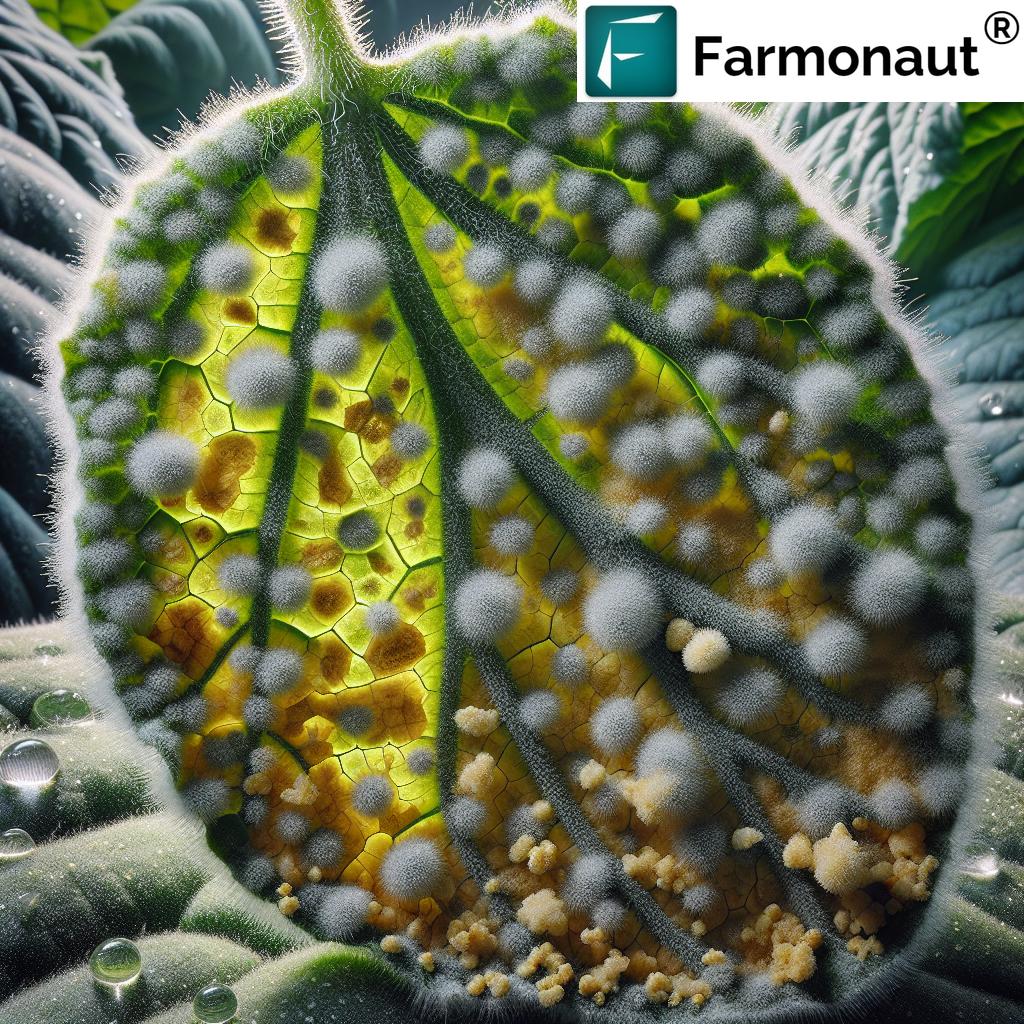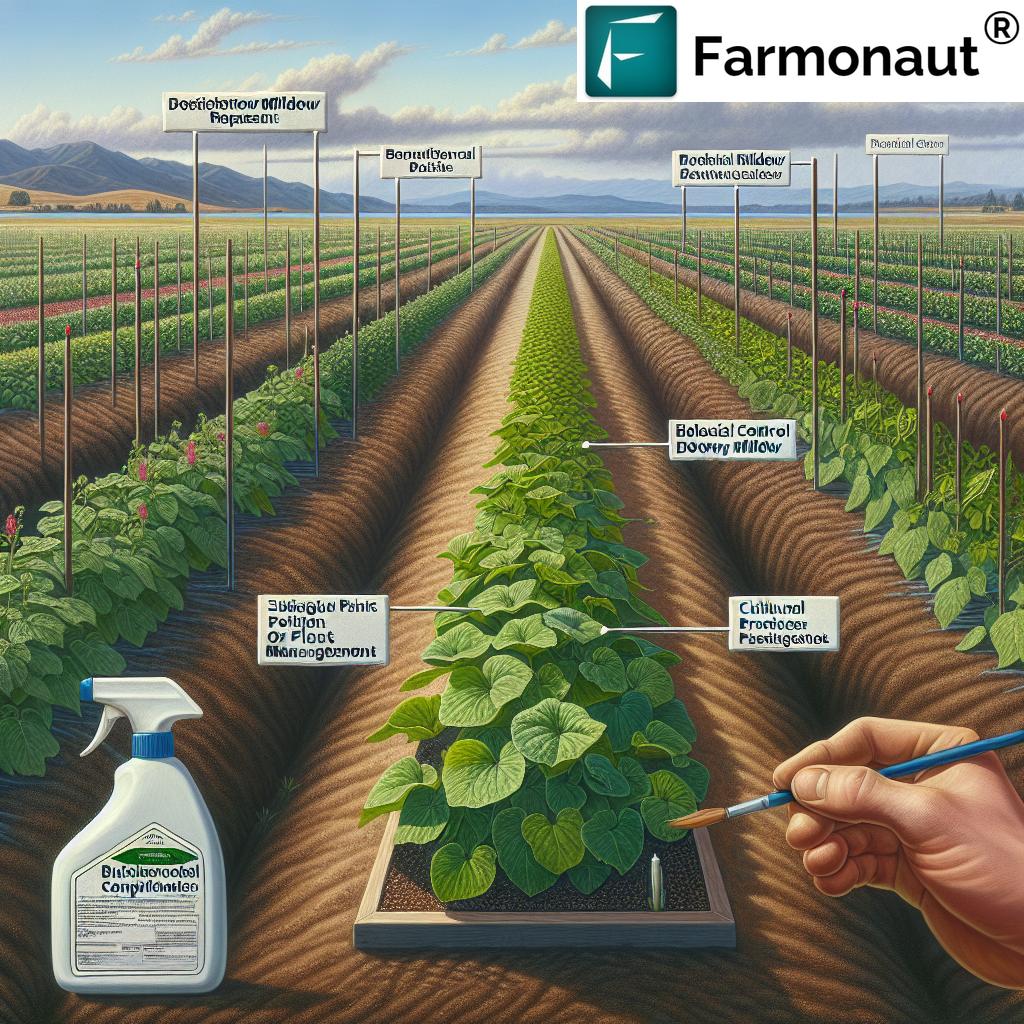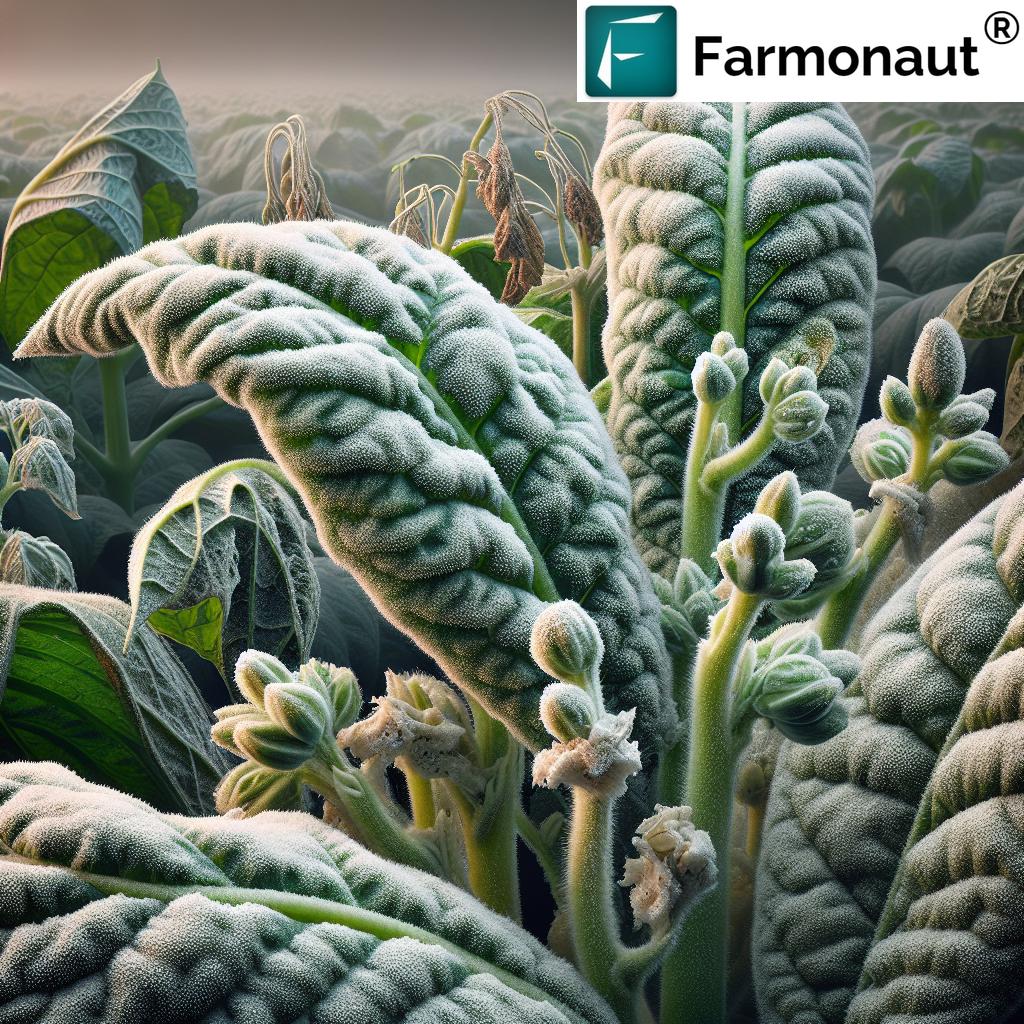Effective Treatment for Downy Mildew: 7 Top Methods
“Downy mildew can reduce crop yields by up to 50% if not managed with effective control methods.”
Table of Contents
- Understanding Downy Mildew
- Symptoms of Downy Mildew Infection
- Comparing Downy Mildew Treatment Methods
- 7 Top Methods for Downy Mildew Control
- Farmonaut: Satellite-Based Agritech Solutions for Disease Management
- Frequently Asked Questions (FAQ)
- Conclusion
Understanding Downy Mildew
Downy mildew is a highly destructive plant disease affecting a wide array of crops, such as vegetables, fruits, and ornamental plants. The disease is primarily caused by several oomycete pathogens, including Peronospora, Plasmopara, and Pseudoperonospora species, which thrive under specific environmental conditions. Downy mildew pathogens are classified as obligate biotrophs, meaning they need living host tissue to complete their life cycle.
The pathogens infect the leaves of susceptible plants, developing characteristic pale green or yellow lesions on the upper leaf surface and a fluffy, downy growth underneath. Under cool temperatures (40° to 70°F) and high humidity (≥90%), the pathogen’s sporangia rapidly spread, leading to severe infection, crop yield losses, and reduced quality—the importance of downy mildew control cannot be overstated for every grower intent on reducing disease impact.
Symptoms of Downy Mildew Infection
- Pale green to yellow lesions usually appear first on the upper leaf surface.
- A characteristic fluffy, downy growth (sporangia) becomes visible on the lower leaf surface, especially in humid conditions.
- Lesions may turn brown and necrotic as they expand, often surrounded by a yellow halo.
- Infected leaves may curl, wilt, and eventually die, leaving plants vulnerable to secondary pathogens.
- In severe infections, crop yields are significantly diminished, especially in vegetables (e.g., cucumbers, lettuce), fruits (e.g., grapes), and ornamental plants.
Accurately identifying these symptoms of downy mildew infection is critical for timely intervention and effective management strategies.
“Over 7 proven strategies exist to combat downy mildew, including cultural, chemical, and biological approaches.”
Comparing Downy Mildew Treatment Methods
To assist growers in managing downy mildew, compare the 7 most effective disease control methods for vegetables, fruits, and ornamental plants.
| Downy Mildew Treatment Method | Method Type | Description | Estimated Effectiveness (% Disease Reduction) | Cost Level | Application Frequency | Environmental Impact |
|---|---|---|---|---|---|---|
| Cultural Practices (Spacing, Pruning, Irrigation, Sanitation) | Cultural | Adjusting plant spacing, promoting air circulation, careful irrigation, and sanitation to minimize favorable conditions for downy mildew development | 50–70% | Low | Ongoing | Low |
| Chemical Fungicides (Mancozeb, Azoxystrobin, etc.) | Chemical | Preventative and curative fungicide applications targeting downy mildew | 60–90% | Medium/High | Weekly/Biweekly or per label | Moderate/High |
| Resistant Varieties | Cultural/Genetic | Planting crops bred for resistance to downy mildew infection | 70–95% | Medium | Per season at planting | Low |
| Biological Controls (e.g., Bacillus spp., Streptomyces spp.) | Biological | Using beneficial microbes to suppress downy mildew pathogens | 40–70% | Medium | Weekly or as needed | Low |
| Induced Resistance (e.g., Salicylic Acid Derivatives) | Biological/Chemical | Enhancing plant defensive response to resist downy mildew infection | 30–60% | Medium | Ongoing/Multiple times in season | Low |
| Monitoring & Forecasting | Integrated Tech/Cultural | Regularly scouting crops, using weather-based models to forecast outbreaks, enabling timely intervention | Varies (Supplemental) | Low/Medium | Continuous during growing season | Low |
| Integrated Disease Management (IDM) | Integrated | Combining cultural, chemical, biological & technological tools for best results | Above 90% | Medium | Season-long | Low/Moderate |
7 Top Methods for Downy Mildew Control
Let’s break down each method, explain their importance, and share practical examples for real-world application, supporting sustainable agriculture and preventing crop yield losses from downy mildew.
1. Cultural Practices for Plant Disease Management
Cultural control remains the foundation for success in downy mildew control. Key practices include:
- Plant Spacing and Pruning: Allow sufficient spacing between plants and regularly prune to enhance air circulation around foliage. Rapid drying of leaves helps disrupt the pathogen’s development cycle and reduces moisture—ideal conditions for sporangia spread.
- Drip or Microsprinkler Irrigation: Use drip irrigation to water the soil directly rather than overhead watering, avoiding wetting of leaves. This practice greatly reduces relative humidity on the plant’s surface layer, limiting disease infection periods.
- Sanitation: Swiftly remove and destroy infected plant debris post-harvest or after pruning. Proper disposal of infected leaves and stems lowers the pathogen’s inoculum load, decreasing risk for the next growing season.
- Crop Rotation: Avoid planting downy mildew hosts in the same field season after season, which can build up infectious soil populations.
By applying these cultural practices for plant disease management, farmers can proactively reduce infection rates in their fields, promoting robust plant development, and supporting the overall health of crops.
Example: Downy Mildew in Vegetables and Fruits
In crops such as cucumber, lettuce, and grapevine, the combination of proper plant spacing, pruning of dense foliage, and avoiding late afternoon/evening irrigation has proven to significantly limit downy mildew development.
2. Chemical Fungicides for Downy Mildew
In geographic regions or seasons with persistent high risk, chemical fungicides for downy mildew become essential tools. Key aspects of this chemical approach include:
- Fungicide Selection: Choose products with demonstrated action against oomycete pathogens, such as mancozeb, azoxystrobin, cyazofamid, fluopicolide, mafenoxam, and phosphorous acid. Always refer to local agricultural extension recommendations for authorized applications on your crop.
- Preventative Applications: Apply fungicides prior to visible disease symptoms, especially ahead of forecasted cool, humid spells. Once infection is advanced, chemical control is much less effective.
- Resistance Management: Rotate fungicides with different modes of action (e.g., alternate between protective and systemic products), and mix with multisite contact fungicides to delay fungicide resistance in pathogen populations.
- Systemic Fungicides: Some modern systemic fungicides offer protection to both newly forming tissue and existing foliage, improving overall disease suppression.
Adhering to correct application timing, intervals, and label rates is essential not only for efficacy but also for environmental safety.
Example: Downy Mildew in Cucumber Cultivation
Downy mildew can devastate cucumber fields. In such cases, alternating systemic actives like azoxystrobin and protector fungicides such as mancozeb offers high percent control, especially when started before the first symptoms.
Integrate real-time satellite and weather data from Farmonaut’s API for disease risk assessment in your custom crop protection program.
Explore Farmonaut API docs for multi-location crop disease risk monitoring integrations.
3. Downy Mildew Resistant Crops & Varieties
Deploying downy mildew resistant crops is an efficient, sustainable method—reducing reliance on chemical interventions. Breeders regularly introduce vegetables, fruits, and ornamentals with improved genetic resistance to local downy mildew species. Key steps include:
- Identifying Resistant Cultivars: Choose varieties (for cucumber, look for Calypso, Dasher II, etc.) that have been bred for resistance or tolerance to the disease.
- Rotation: Rotate different resistant cultivars to minimize the adaptation of the pathogen population and to preserve the effectiveness of resistance genes.
Resistant varieties are a cornerstone for preventing crop yield losses from downy mildew in highly susceptible regions or during conducive environmental periods.
4. Biological Control of Downy Mildew
Growing interest in sustainability fuels the use of biological control of downy mildew as part of integrated management:
- Microbial Agents: Some commercial products contain beneficial bacteria (e.g., Bacillus spp., Streptomyces spp.) that colonize leaf surfaces and inhibit the growth of downy mildew pathogens.
- Application Timing & Frequency: Biological products typically require repeat applications for consistent disease suppression and work best as a supplement to cultural or chemical measures.
- Environmental Impact: Biological agents have a much lower environmental footprint compared with conventional fungicides.
While biological methods may not be solely sufficient during severe epidemics, they are crucial components for organic production and for sensitive ecosystems.
5. Induced Resistance Methods
Induced resistance involves stimulating the plant’s own defense systems against oomycete pathogens:
- Biochemical Inducers: Compounds such as salicylic acid derivatives, chitosan, or other plant extracts can “prime” the plant, activating genes that fend off downy mildew infection.
- Integration: Use alongside fungicides and cultural practices for cumulative, synergistic disease suppression.
Induced resistance is an emerging field and offers additional tools especially for reducing reliance on classic chemical fungicides.
6. Monitoring and Forecasting
Early warning and responsive action are crucial for effective disease management:
- Field Scouting: Regular monitoring enables identification of first disease lesions, leading to prompt fungicide or biological applications.
- Weather-Based Forecasting: Models that predict downy mildew outbreaks by tracking air temperature, humidity, and leaf wetness duration can help time interventions optimally.
For the most robust downy mildew control program, combine field scouting with technological solutions for near real-time surveillance and notifications.
7. Integrated Downy Mildew Management
The single most effective approach is to integrate multiple downy mildew control strategies. This integrated approach combines the strengths of cultural, chemical, biological, and technological controls for sustainable, superior results with minimal negative environmental impact.
- Cultural Practices set the baseline for reducing disease pressure across all crops.
- Chemical Fungicides are reserved for periods of high risk, and always rotated or mixed for resistance management.
- Resistant Cultivars offer a season-long shield, especially in crops like cucumber, lettuce, grape, and various ornamentals.
- Biological Agents and Induced Resistance are integrated for lower chemical reliance and environmental stewardship.
- Technological Tools enable risk mapping and optimized intervention scheduling.
The highest estimated effectiveness for downy mildew control—often exceeding 90%—is achieved through Integrated Disease Management (IDM).
Farmonaut: Satellite-Based Agritech Solutions for Disease Management
Farmonaut leverages advanced technologies to help the agricultural community manage plant disease and optimize crop yield. Our solutions offer:
- Satellite-Based Crop Health Monitoring: Using multispectral satellite imagery, we help monitor crop vigor, detect early stress or disease formation, and locate downy mildew hotspots remotely.
- Jeevn AI Advisory System: Our AI-driven platform delivers real-time, personalized crop management recommendations—including disease risk notifications based on environmental sensors, weather forecasts, and satellite data.
-
Blockchain-Based Product Traceability: Our traceability solutions ensure the history of your products is kept transparent—enhancing trust, food safety, and opening up premium markets for sustainably grown crops.
View Farmonaut Traceability Solutions -
Fleet and Resource Management: Optimize your logistics and minimize waste with real-time vehicle, equipment, and labor management.
See Our Fleet Management Suite -
Carbon Footprinting: Track and reduce your carbon footprint in crop protection and land management.
Farmonaut Carbon Tracking Platform
By integrating Farmonaut’s technology into your operation, you individualize your downy mildew control protocol, increase efficiency, save input costs, and enhance yield, while practicing sustainable farming.
Frequently Asked Questions (FAQ)
What environmental conditions favor downy mildew development?
Downy mildew thrives in cool (40°–70°F), humid (≥90% humidity) weather, especially when leaf wetness persists from rain, fog, or overhead irrigation.
Which crops are most affected by downy mildew?
Crops at highest risk include cucumbers, squash, melons, lettuce, spinach, grapes, onions, and ornamental plants such as impatiens and roses.
Can I stop using fungicides if I use resistant varieties?
While downy mildew resistant crops decrease risk greatly, combining with cultural and monitoring methods is recommended; resistant breakdown can occur in certain populations or environments.
Are biological agents safe for pollinators and beneficial insects?
Most biological agents (e.g., Bacillus spp., Streptomyces spp.) used for biological control of downy mildew are compatible with natural enemies and pollinators, but always check product-specific labels.
How does precision agriculture improve disease management?
Tools like Farmonaut’s satellite crop monitoring provide near-real-time field health data, making it easier to detect outbreaks early and apply disease control strategies only where and when needed—boosting downy mildew control efficacy and minimizing cost and environmental impact.
What causes fungicide resistance in downy mildew?
Overuse of the same mode of action (chemical class) of fungicides allows pathogen populations to adapt, making those products less effective. Rotation and tankmixing are key strategies for resistance management.
How quickly can downy mildew destroy a crop if not managed?
During optimal conditions (cool temperatures, high humidity), downy mildew can devastate entire susceptible crop fields in as little as 1–2 weeks if not effectively managed.
Conclusion
Downy mildew continues to pose a major threat to global food security, from smallholder plots to commercial farms. Success in downy mildew control depends on early identification, understanding the disease’s life cycle, and deploying a suite of integrated cultural, chemical, and biological methods tailored to your crops and local environmental conditions.
As agricultural technologies advance, real-time monitoring, disease forecasting, and data-driven interventions—such as those offered on the Farmonaut platform—empower stakeholders to optimize resource use, reduce losses, and future-proof production against oomycete pathogens.
No single solution is universally effective, but by combining these 7 top methods for managing downy mildew, we support a resilient, productive, and environmentally responsible farming future for vegetables, fruits, and ornamental plants worldwide.


















